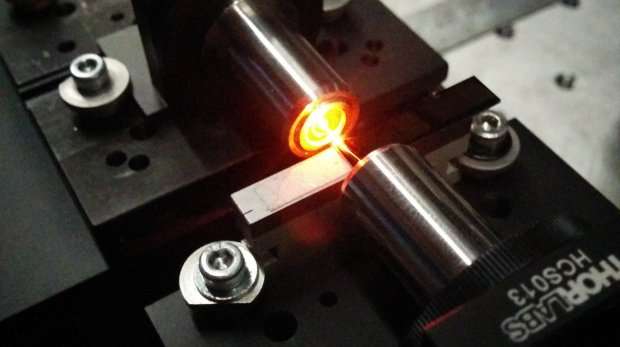Research team 'activates' photonic chip for communication with light

Sending information with the help of light is the future. It requires 'light chips', made of a special glass. Scientists from the UT research institute MESA+ have now managed to equip these light chips - which were already known for their extremely low losses - with new 'active' functionalities, such as generating, strengthening, and modulating light. Their chip is capable of creating a very wide light spectrum that runs from blue to infrared, spanning wavelengths of 470 to 2130 nanometres. By doing so they have made a light chip with the largest frequency range ever. The research has been published in the scientific journal Optics Express this summer.
You can send information with the help of light. For example, think of glass fibres that you can use to send digital information from one computer to the other. The width and regularity of the light spectrum plays a central role in this. With a broader spectrum (meaning a larger variety of colours in the light) and a large number of light channels set next to each other (individual colours), you can process a larger amount of information faster.
Creating such a spectrum with many individual lasers is technically very complex, expensive and less precise. Researchers have, therefore, been looking for methods to generate the broadest possible light spectrum on a chip for a long time. University of Twente scientists have now successfully managed to create a light chip with the broadest light spectrum ever. Their chip achieves a bandwidth of 495 THz, which is over half more than the previous record. According to research leader Prof. Dr Klaus Boller this broad spectrum demonstrates the potential of the technology. "However, the most important breakthrough is that we have managed to create it with the help of materials that have already proven themselves in practice. These materials have the lowest optic losses on a chip and are, therefore, already extremely relevant. What's more, the fabrication matches the standard processes in the chip industry, making it suitable for mass production."
Extra thick
In order to generate the broad spectrum, the researchers shone laser light into a structure that guides light, called a waveguide, made of a glass-like material, silicon nitride, embedded in regular glass (silicon oxide). The shape and construction of the waveguide ensures that the laser light generates new colours of light as it passes through—in this case going from 4 THz to a remarkable 495 THz. One of the key challenges of the research was ensuring that the silicon nitride did not crack during the manufacture of the waveguides. However, with a new fabrication technique, the researchers of the University of Twente managed to create a structure that is thick enough, 800 nanometres.

Frequency comb
The spectrum created by the chip is not constant, but consists of about twelve million peaks that lie at exactly the same distance from each other. Because of this, the spectrum looks like a hair comb; which is why such spectra have been given the name frequency comb. Frequency combs, a fast-growing field of research, make it possible to not only increase the speed of optic communication techniques, but also to greatly improve the precision of atomic clocks, telescopes, and GPS equipment.
More information: "On-chip visible-to-infrared supercontinuum generation with more than 495 THz spectral bandwidth," Optics Express Vol. 23, Issue 15, pp. 19596-19604 (2015) DOI: 10.1364/OE.23.019596
Journal information: Optics Express
Provided by University of Twente



















